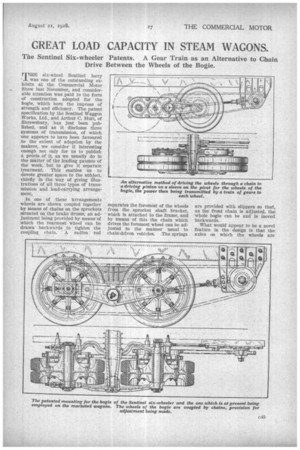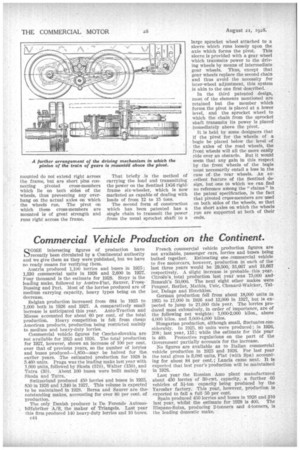GREAT LOAD CAPACITY IN STEAM WAGONS.
Page 27

Page 28

If you've noticed an error in this article please click here to report it so we can fix it.
The Sentinel Six-wheeler Patents. A Gear Train as an Alternative to Chain Drive Between the Wheels of the Bogie.
VI-1HE six-wheel Sentinel lorry 1.1 was one of the outstanding exhibits at the Commercial Motor Show last November, and considerable attention was paid to the form of construction adopted for the bogie, which bore the impress of strength and efliciency. The patent specification by the Sentinel Waggon Works, Ltd., and Arthur C. Hutt, of Shrewsbury, has just been published, and as it discloses three systems of transmission, a which one appears to have been favoured to the extent of adoption by the makers, we consider it interesting enough not only for us to publish a précis of it, as we usually do in the matter of the leading patents of the week, but to give it separate treatment. This enables us to devote greater space to the subject, chiefly in the way of giving illustrations of all three types of transmission and load-carrying arrangement.
In one of these 'arrangements wheels are• shown coupled together by means of chains on the sprockets situated on the brake drums, an adjustment being provided by means' of which the rearmost wheel can be drawn backwards to tighten the coupling chain. A radius rod separates the foremost of the wheels from the sprocket shaft bracket, which is attached to the frame, and by means of this the chain which drives the foremost wheel can be adjusted in the manner usual to chain-driven vehicles. The springs are provided with slippers so that, as the front chain is adjusted, the whole bogie can be and is moved backwards.
What would appear to be a novel feature in the design is that the axles on which the wheels are mounted do not extend right across the frame, but are short pins connecting pivoted cross-members which lie on both sides of the wheels, thus preventing any overhang on the actual axles on which the wheels run. The pivot on which these cross-members are mounted is of great strength and runs right across the frame. That briefly is the method of carrying the load and transmitting the power on the Sentinel DG6 rigidframe six-wheeler, which is now marketed as capable of dealing with loads of from 12 to 15 tons.
The second form of construction which has been patented has a single chain to transmit the power from the usual sprocket shaft to a large sprocket wheel attached to a sleeve which runs loosely upon the axle which forms the pivot. This sleeve is provided with a gear wheel which transmits power to the driving wheels by means of intermediate gear wheels. Thus, except that gear wheels replace the second chain and thus avoid the necessity for inter-wheel adjustment, this system is akin to the one first described.
In the third patented design, most of the elements mentioned are retained but the member which forms the pivot is placed at a lower level, and the sprocket wheel to which the chain from the sprocket shaft transmits its power is placed immediately above the pivot.
It is held by some designers that if the pivot for the wheels of a bogie be placed below the level of the axles of the road wheels, the front wheels will all the more easily ride over an obstacle. But it would seem that any gain in this respect by the front wheels of the bogie most necessarily entail a loss in the case of the rear wheels. An excellent feature of the Sentinel design, but ,one to which we can find no reference among the "claims" in the patent" specification, is the fact that pivoted cress-members are used on both sides of the wheels, so that the short axles on which the wheels run are supported at both of their ends.


































